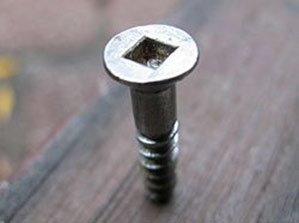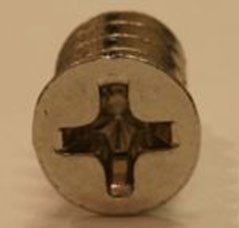A screwdriver is a tool for the insertion and tightening of screws. The screwdriver is made up of a head or tip, which engages with a screw, a mechanism to apply torque by rotating the tip, and some way to position and support the screwdriver. A typical hand screwdriver comprises an approximately cylindrical handle of a size and shape to be held by a human hand, and an axial shaft fixed to the handle, the tip of which is shaped to fit a particular type of screw. The handle and shaft allow the screwdriver to be positioned and supported and, when rotated, to apply torque. Screwdrivers are made in a variety of shapes, and the tip can be rotated manually or by an electric motor or other motor.
A screw has a head with a contour such that an appropriate screwdriver tip can be engaged in it in such a way that the application of sufficient torque to the screwdriver will cause the screw to rotate.
The screwdriver was invented in Germany in the late fifteenth century. Originally called a ‘screwturner,’ the first documentation of the tool is in the ‘’’The Medieval Housebook of Wolfegg Castle’’’, published sometime between 1475 and 1490 AD. The original screwdriver had a pear-shaped handle and was made for slotted screws (Diversification of the many types of screwdrivers did not emerge until the Gilded Age). This time period roughly coincides with the appearance of the adjustable screw. The screwdriver remained conspicuous, however, as evidence of its existence throughout the next 300 years was based primarily on the presence of screws.
Screws were used in the 15th century for constructing screw-cutting lathes, securing breastplates, backplates, and helmets on Medieval Jousting armor, and eventually for multiple parts of the emerging firearms, particularly the matchlock. Screws, hence screwdrivers, were not used in full combat armor, most likely to give the wearer freedom of movement.
The jaws holding the pyrites inside Medieval guns were secured with screws, and the need to constantly replace the pyrites resulted in considerable refinement of the screwdriver. The tool was much more documented in France, where it took on the name ‘’’turnscrew’’’ (The French word for screwdriver is tournevis, the literal translation of turnscrew) and took on many different shapes and sizes, though every version was still for slotted screws. There were large, heavy duty screwdrivers for building and repairing large machines, and more popular, smaller screwdrivers for refined cabinet work. This was the dominant use of expensive screws and consequently the rare screwdriver for centuries.
Illustration from Robertson's patent application
The screwdriver was, of course, entirely dependent on the screw, and it wasn’t until several advances that the screw became easy enough to produce to become popular and widespread. The most popular doorhinge at the time was the butt-hinge, but it was considered a luxury at the time. The butt-hinge was handmade, and its constant motion meant that it required the security of a screw.
Screws were very hard to produce before the First Industrial Revolution, requiring manufacture of a helix on a cylindrical surface that cones off. Two brothers, Job and William Wyatt, found a way to produce a screw on an assembly line type machine, that first cut the slotted head, and then carved the helix. Though their business ultimately failed, their contribution to the screw ultimately lead to a vast increase in the screw and the screwdriver’s popularity.
The increase in popularity ultimately lead to refinement and eventually diversification of the screwdriver. Refinement of the precision of screws also significantly contributed to the boom in production, mostly by increasing its efficiency and standardizing sizes, important precursors to industrial manufacture.
 Close-up of Robertson screw
Close-up of Robertson screw
One of the most popular new designs of the screwdriver was made by Canadian P.L. Robertson, who inadvertently invented the screwdriver when he patented the first socket-headed screw in 1907. Socket screws rapidly grew in popularity, and are still a favorite of mechanics today for their resistance to wear and tear, compatibility with hex keys, and ability to stop a power tool when set. Though immensely popular, Robertson had trouble marketing his invention to the newly booming auto industry, for he was unwilling to relinquish his patents.
Meanwhile, Henry F. Phillips patented his own invention, an improved version of a deep socket with a cruciform, today known as the Phillips Screw. The Phillips screw was offered by Phillips to the American Screw Company, and after a successful trial on the 1936 Cadillac Cadillac, quickly swept through the American auto industry. With the Industrial Revival at the end of the Great Depression and the onslaught of World War II, the Phillips screw quickly became, and still remains, the most popular screw in the World. A main attraction for the screw was that conventional slotted screwdrivers could also be used on them, which ostracized the Robertson Screw, still a favorite among experts.
 Phillips screw head
Phillips screw head
The Screwdriver remains one of the most common tools both in household use and in professional manufacture.
Gunsmiths still refer to a screwdriver as a "turnscrew", under which name it is an important part of a set of pistols. The name was common in earlier centuries, used by cabinet makers and shipwrights and perhaps other trades.
The Cabinet-Maker's screwdriver is one of the longest-established handle forms, somewhat oval or elipsoid in cross section. This is variously attributed to improving grip or preventing the tool rolling off the bench. The shape has been popular for a couple of hundred years. It is usually associated with a plain head for slotted screws, but has been used with many head forms. Modern plastic screwdrivers use a handle with a roughly hexagonal cross section to achieve these same two goals, a far cry from the pear-shaped handle of the original fifteenth century screwdriver[1].
Drive types
Screwdrivers come in a large variety of sizes to match those of screws, from tiny jeweler's screwdrivers up.
If a screwdriver that is not the right size and type for the screw is used, it is likely that the screw will be damaged in the process of tightening it. This is less important for PoziDriv and SupaDriv, which are designed specifically to be more tolerant of size mismatch. When tightening a screw with force, it is important to press the head hard into the screw, again to avoid damaging the screw.
Some screwdriver tips are magnetic, so that the screw remains attached to the screwdriver without requiring external force. This is particularly useful in small screws, which are otherwise difficult to handle.
Many screwdriver designs have a handle with detachable head (the part of the screwdriver which engages with the screw), called bits as with drill bits, allowing a set of one handle and several heads to be used for a variety of screw sizes and types.
Many modern electrical appliances, if they contain screws at all, use screws with heads other than the typical slotted or Phillips styles. TORX is one such pattern that has become very widespread. The main cause of this trend is manufacturing efficiency: TORX and other types are designed so the driver will not slip out of the fastener as will a Phillips driver. (Slotted screws are rarely used in mass-produced devices, since the driver is not inherently centered on the fastener.) A benefit/disadvantage of non-typical fasteners (depending on your point of view) is that it can be more difficult for users of a device to disassemble it than if more-common head types were used, but TORX and other drivers are widely available. Specialized patterns of security screws are also used, such as the Gamebit head style used in all Nintendo consoles, though drivers for most security heads are, again, readily available.